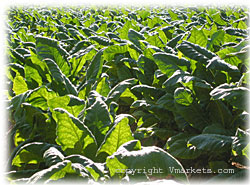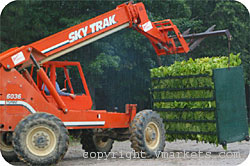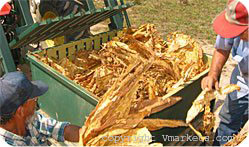
 |
|||
Tobacco (Tobacco Buyout Bill Summary) | |
North Carolina produces more flue- cured tobacco and manufactures more tobacco products than any comparable area in the world. It accounts for almost two-thirds of the nation's annual production of flue-cured leaf and ranks first in cash receipts from the golden leaf. Tobacco is grown in 82 of the 100 counties. Tobacco farm families work year-round, devoting some 300 man-hours in producing one acre of leaf, among the most labor intensive of crops. Cultivation begins with the selection of a site for a plant bed, usually 50 to 100 square yards for each acre of tobacco the farmer hopes to harvest. When the soil is warm enough, the seedlings are moved from seedbed to field and planted in rows 3 to 4 feet apart. When blossoms first appear, the plant is 'topped' by breaking or cutting off the top. Those remaining can thus utilize the plant's nutrients to become larger, thicker and heavier. When lateral buds, or 'suckers' develop in the leaf axils, they are removed by hand or with chemicals, so as not to reduce the size of other leaves.
Tobacco farm families work year-round, devoting some 300 man-hours in producing one acre of leaf, among the most labor intensive of crops. Cultivation begins with the selection of a site for a plant bed, usually 50 to 100 square yards for each acre of tobacco the farmer hopes to harvest. When the soil is warm enough, the seedlings are moved from seedbed to field and planted in rows 3 to 4 feet apart. When blossoms first appear, the plant is 'topped' by breaking or cutting off the top. Those remaining can thus utilize the plant's nutrients to become larger, thicker and heavier. When lateral buds, or 'suckers' develop in the leaf axils, they are removed by hand or with chemicals, so as not to reduce the size of other leaves.The plants are mature 60 to 90 days after transplant. Harvesting is done by one of two methods. 'Priming' - the leaves picked individually as they ripen - is used for flue-cured. In 'stalkcutting', used for burley, the entire plant is felled. Cured properly, the tobacco becomes brittle.  So it is piled in heaps to absorb moisture from the warm, humid air common during tobacco season. When soft and pliable enough to be handled without breaking, it is 'in case' or 'in order' and ready for market. So it is piled in heaps to absorb moisture from the warm, humid air common during tobacco season. When soft and pliable enough to be handled without breaking, it is 'in case' or 'in order' and ready for market.North Carolina's flue-cured tobacco is sold at auction July through October, burley November through January. Dozens of auction markets are scattered throughout the state, most near major leaf producing areas. Every state has a stake in the tobacco industry, considering the vast amounts of material, equipment, and services involved between seed and sale. An extensive distribution network supplies finished products to retailers throughout the state. Tarheel consumers spend hundreds of millions annually over the counter and in vending purchases for tobacco products, pipes and other smokers' articles.  The golden leaf, through the years, has made an incalculable contribution to the growth and well-being of North Carolina. It has contributed to employment, incomes and tax revenues through farming, auctioning, manufacturing, wholesaling and retailing activities and essential industry supply operations. The golden leaf, through the years, has made an incalculable contribution to the growth and well-being of North Carolina. It has contributed to employment, incomes and tax revenues through farming, auctioning, manufacturing, wholesaling and retailing activities and essential industry supply operations.The proper management of pests can improve tobacco quality and yield while reducing costs. Tobacco is a valuable crop. Therefore, any problem should be quickly identified and a solution determined. Accurate identification of tobacco problems involves at least five steps. 1.Conduct an unbiased assessment of the field 2.Determine the pattern of plant symptoms in the field 3.Characterize plant injury symptoms 4.Note the crop growth stage 5.Obtain field history information | |